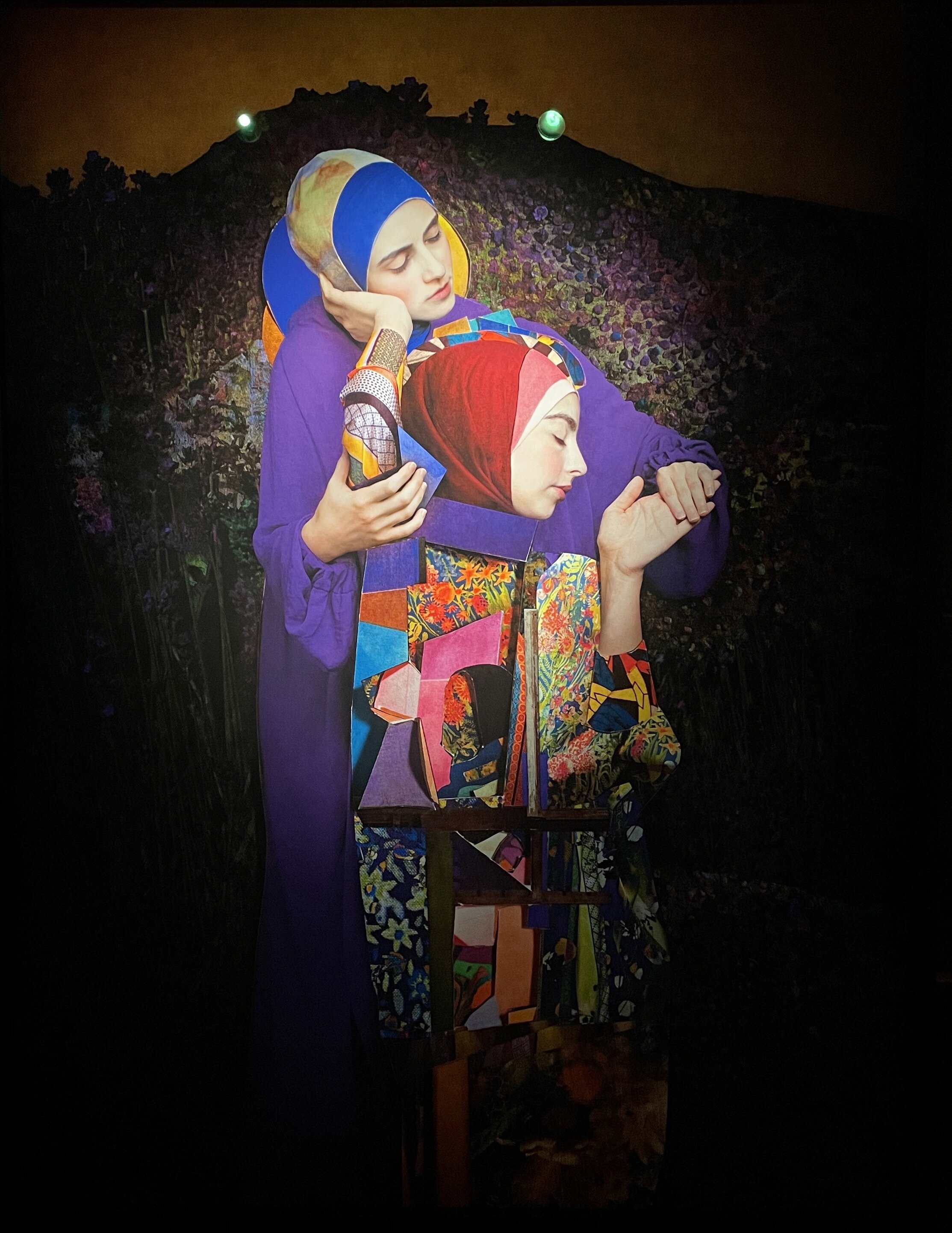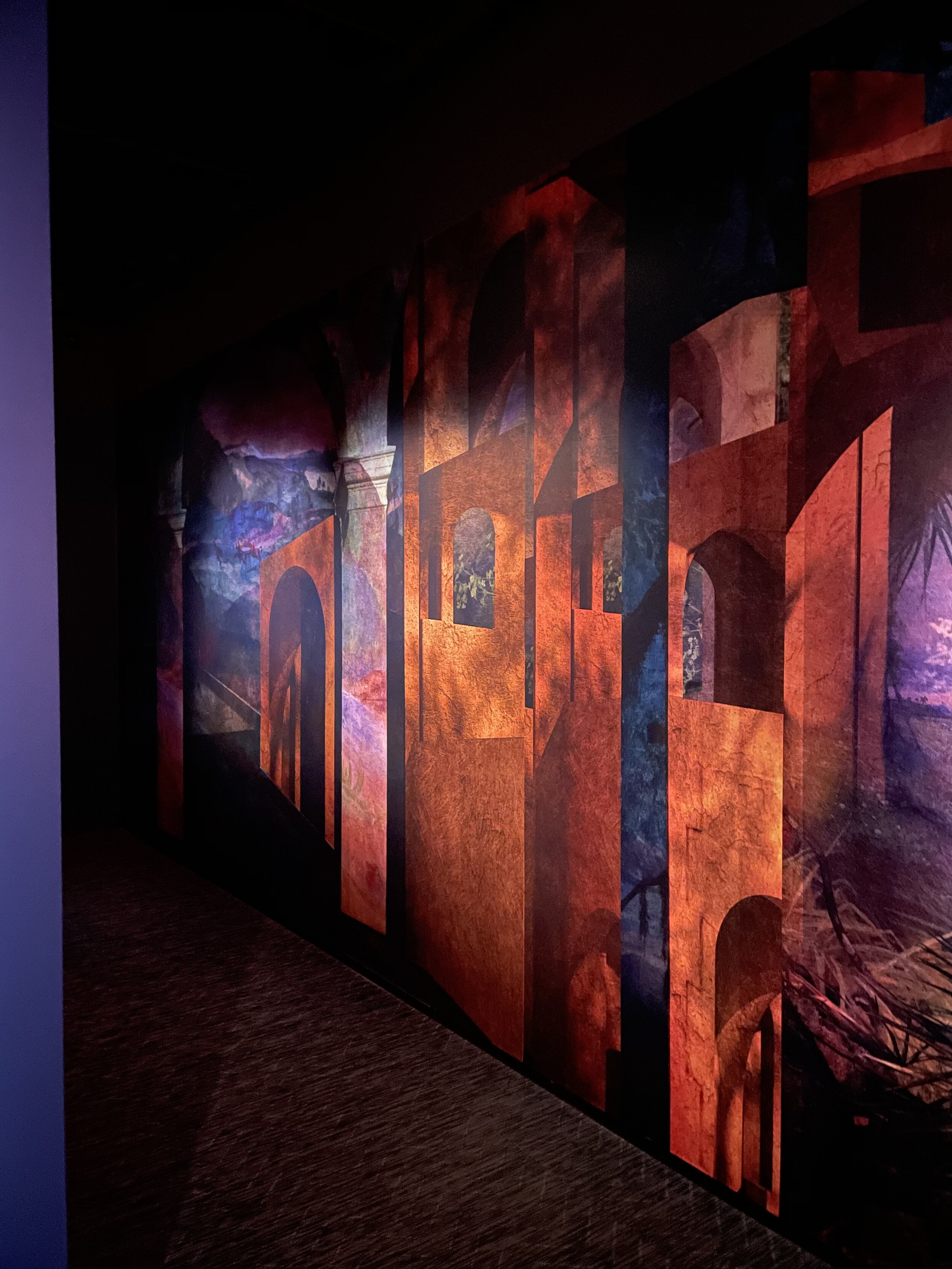A Cocoon of Memory: Intersections of Fiction and Reality in “Behind These Folded Walls, Utopia”

A vibrant landscape unravels across these walls, blooming with leaves, with mosaics of textiles that seduce us with their peaks and valleys. A cocoon of kinetic and textural play, Sarah Cooper and Nina Gorfer’s exhibition Behind These Folded Walls, Utopia presents a poignant meditation upon evolving diasporas as well as the moments in which metamorphosis and upheaval may coexist. In their intertwined surfaces and narratives, the portraits featured in the exhibition fabricate a multilayered utopia, one that gracefully alternates between fiction and collective history. Rather than documenting objective realities, then, Cooper and Gorfer imagine photography and collage as utopian possibilities, capable of resurrecting the memories, joy, and longing of the women they photograph.
On view at Fotografiska in New York until March 2021, Behind These Folded Walls, Utopia weaves together a chorus of stories and lives, all of which center around women who have been uprooted from their homes and subsequently immigrated to Sweden. Constantly wavering upon the “thresholds between reality and the imagined,” as writer Joanna Persman claims, Cooper and Gorfer’s portraiture steep their subjects within a lustrous elasticity that examines the prescribed trajectories of migration, integration, and the self. As goddesses suspended by overlapping fabrics and patterns, as dancers clinging onto one another, and as actors in a surrealist theatre, the women of Behind These Folded Walls interrogate rigid conceptualizations of cultural conditioning and identity formation. Each portrait emanates a rare faculty for touch and for the sensual qualities of memory, thus escaping familiar iconography while locating a visual vocabulary guided by the body and by its impulse to survive. “What does it mean to be uprooted?” the exhibition asks, “What does it mean to be part of several cultures at once, but belong to neither one of them entirely?”
Although driven by these considerations, Behind These Folded Walls doesn’t strive for finitude nor for a concrete answer. Rather, the exhibition conjures visions of a new utopia, one existing at the intersection of contemporary politics, imagination, and a growing diaspora of young women that, according the exhibition text, “integrate themselves, remove themselves, paste themselves in, or cut themselves out of this labyrinthian coulisse.” By unearthing this capacity for transformation, Cooper and Gorfer’s portraits enable their subjects to carve their own distinct narratives through personal objects hidden in the crevices of collaged textures and a palette of vibrant colors. This luscious, playful world is one fundamentally informed by its subjects as well as the photographers’s preoccupation with memory and imagination, dual functions that derive from the ability to see and to recollect.
Yohana Holding Scissors. Courtesy of Fotografiska.
Interrupted by shards of fabric, leaves, and architectural arches, Yohana Holding Scissors, for example, concretizes Cooper and Gorfer’s photographs not as vehicles of documentation but as an exercise in storytelling. Maintaining an unobstructed gaze that directly confronts the viewer, Yohana begins to melt at her shoulders, the assemblage of textures assuming the role of a body as her arms slip out from beneath the foliage. The jewelry, intersecting patterns, and textiles that adorn Yohana clash and harmonize with one another, resisting neat, linear narratives that could otherwise risk simplifying Yohana’s forced migration from Eritrea to Sweden in 2015. As a multisensory and multilayered portrait, Yohana Holding Scissors synthesizes various strands of the self, reflecting cultural histories, loss, and an image of resilience. The scissors Yohana grips in her fingers, however, further complicate a “readymade understanding of the world.” In severing elements of the portrait with her scissors while simultaneously pasting herself into her collaged environment, Yohana undergoes a profound metamorphosis, one that positions her as a creator, a crafter, and a storyteller that isn’t entirely uprooted nor submerged.
Israa and Salam in Pattern. Photograph courtesy of the author.
Despite most often mapping the trajectories of individual women, Behind These Folded Walls also contemplates the encounters between collective bodies. Recalling the imagery of the Renaissance and its modernist adaptations, Cooper and Gorfer’s Israa and Salam in Pattern stages the body as magnetic, depicting a tender yet melancholic embrace shared between Israa and Salam. Although the gallery plaque acknowledges that Salam—the woman draped in purple—is about four years older than Israa, Salam nevertheless seems to haunt the photograph as the memory of a mother or a mother’s touch. With an expression that outwardly masks an interior solitude or grief, Salam recedes into the patterned background while Israa continues to arrest our gaze with her vibrant, heavily textured clothing. This double movement of Israa and Salam in Pattern suggests the simultaneous familiarity and dislocation that arises from migration, with Israa and Salam occupying a territory of intense ambiguity. As a constellation of collective and uprooted memories, this portrait mediates the intimacies of found family and the loss of home.
During an interview in 1996, the cultural historian Thomas Berry claimed, “If a particular society’s cultural world—the dreams that have guided it to a certain point—become dysfunctional, the society must go back and dream again.” The utopia constructed throughout Behind These Folded Walls participates in Berry’s project of “dreaming,” of envisioning a theatrical, subjective landscape in which reality and imagination blur. While the “dysfunctional” qualities of our current political moment are certainly interrogated, the portraits in Behind These Folded Walls look toward a utopia built upon elasticity, one that, as these women delve into fantastical atmospheres, seems more immediate than it does unfathomable. “We are here now,” the final text of the exhibition reads, “All her, all ready.”








